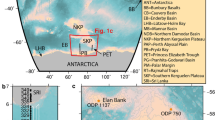Play all audios:

ABSTRACT McKenzie and Parker1 have shown from displacements along faults and from seismic first motions that the North Pacific seems to be moving as a rigid plate relative to the surrounding
continents. This motion is uniquely defined by a rotation axis which they estimated to be located near 50° N., 85° W. at the southern end of Hudson Bay. The sense is towards the north-west,
clockwise as viewed from the pole. Palaeomagnetic evidence from North America and the magnetization of Pacific Ocean seamounts suggest that this rotation dates from Cretaceous time (108
yr), and that the total angle is perhaps as great as 100°, an average rate of 1° per million years. Access through your institution Buy or subscribe This is a preview of subscription
content, access via your institution ACCESS OPTIONS Access through your institution Subscribe to this journal Receive 51 print issues and online access $199.00 per year only $3.90 per issue
Learn more Buy this article * Purchase on SpringerLink * Instant access to full article PDF Buy now Prices may be subject to local taxes which are calculated during checkout ADDITIONAL
ACCESS OPTIONS: * Log in * Learn about institutional subscriptions * Read our FAQs * Contact customer support SIMILAR CONTENT BEING VIEWED BY OTHERS THE EARLY DRIFT OF THE INDIAN PLATE
Article Open access 24 May 2021 SLAB BUCKLING AS A DRIVER FOR RAPID OSCILLATIONS IN INDIAN PLATE MOTION AND SUBDUCTION RATE Article Open access 12 June 2024 COMPLETING THE LOOP OF THE LATE
JURASSIC–EARLY CRETACEOUS TRUE POLAR WANDER EVENT Article Open access 12 March 2024 REFERENCES * McKenzie, D. P., and Parker, R. L., _Nature_, 216, 1276 (1967). Article ADS Google Scholar
* Grommé, C. S., Merrill, R. T., and Verhoogen, J., _J. Geophys. Res._, 72, 5661 (1967). Article ADS Google Scholar * Richards, M. L., Vacquier, V., and Van Voorhis, G. D.,
_Geophysics_, 32, 687 (1967). Article Google Scholar * Vacquier, V., Proceedings, _Benedum Earth Magnetism Symposium_, 123 (1962). Download references AUTHOR INFORMATION AUTHORS AND
AFFILIATIONS * Institute of Geophysics and Planetary Physics, University of California, San Diego W. E. FARRELL Authors * W. E. FARRELL View author publications You can also search for this
author inPubMed Google Scholar RIGHTS AND PERMISSIONS Reprints and permissions ABOUT THIS ARTICLE CITE THIS ARTICLE FARRELL, W. Has the Pacific Basin moved as a Rigid Plate since the
Cretaceous?. _Nature_ 217, 1034–1035 (1968). https://doi.org/10.1038/2171034a0 Download citation * Received: 02 February 1968 * Issue Date: 16 March 1968 * DOI:
https://doi.org/10.1038/2171034a0 SHARE THIS ARTICLE Anyone you share the following link with will be able to read this content: Get shareable link Sorry, a shareable link is not currently
available for this article. Copy to clipboard Provided by the Springer Nature SharedIt content-sharing initiative
